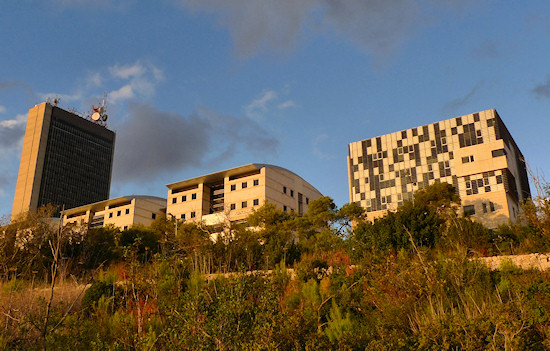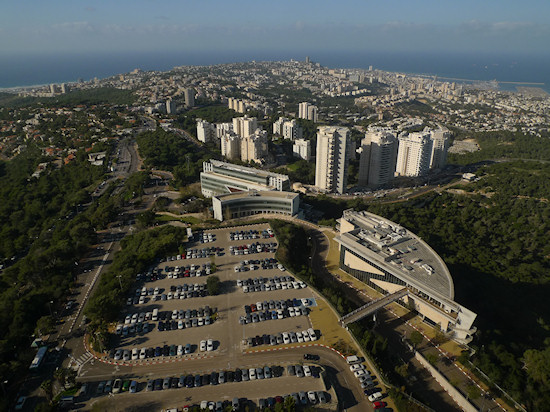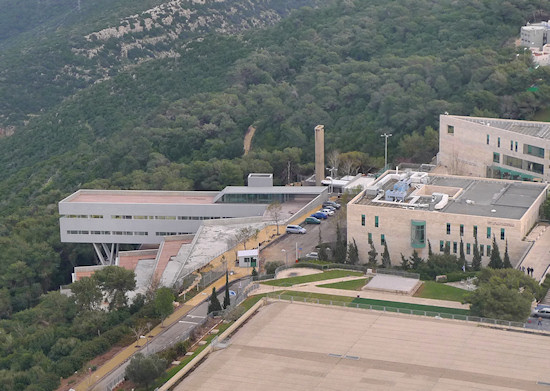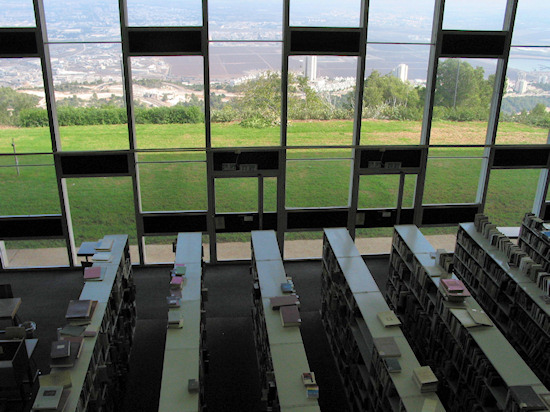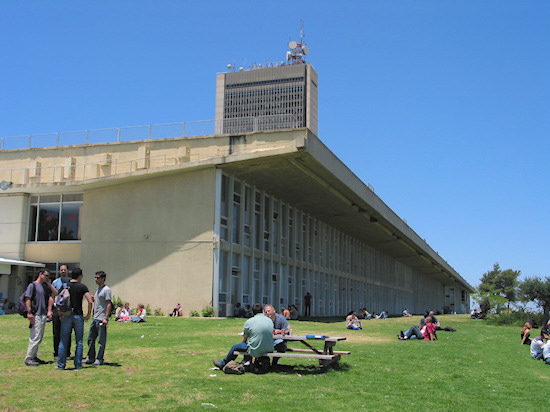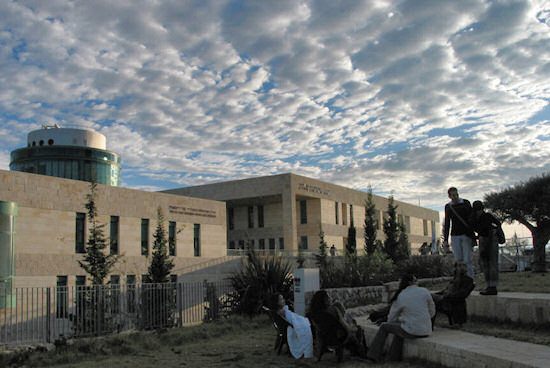Section 9: The University of Haifa – Culture and Academia in the Heights of the Carmel | 2.5 Km
Starting point: Aba Hushi Blvd., Junction of Haifa University north entrance | 440m above sea level
Ending point: Aba Hushi Blvd., Junction of Haifa University north entrance | 440m above sea level
Aba Hushi, Haifa’s mythical mayor, worked tirelessly to establish a university in the city. The mayor invited the renowned Brazilian architect, Oscar Niemeyer, who had designed the Brazilian civic buildings in Brasilia, to plan the Haifa campus. Niemeyer’s Haifa University buildings have a modernistic feel reminiscent of those in Brasilia, particularly the large flat structure adjacent to the tower.
The “Eshkol Tower” was the first structure to penetrate the Carmel’s skyline and, as such, was criticized. The tower did, however, become the hallmark of the university. The university was established in 1963, and represented the connection between academic excellence and social responsibility.
This section begins at Aba Hushi Blvd. at the main junction near the university’s north entrance gate. Ascend to the direction of the gate.
Here you can choose between two options: a circular route (appearing on the trail map) or a path that passes through the buildings.
The circular route turns immediately left after the entrance gate toward the scenic road. Then turn with it to the right and continue on it parallel to the ridge of the Carmel. Views of the valleys and the Galilee appear on your left. At the end of the road is the entrance to the Student Center, which appears as a sharp point jutting from the forested mountain. On the building’s roof, a veranda – which can be entered during the university’s working hours – offers spectacular views.
From the end of the scenic road turn right and go up to a traffic circle where you turn right again. You are now on the campus’ “main street”, on which you will return to the direction of the main gate. Just before the Eshkol Tower you can ascend on a ramp to the roof of the central building for another view. From the main gate, you return to Aba Hushi Blvd. to continue on the Haifa Trail.
For the route through the faculty buildings, continue straight at the northern main gate and enter the main building. Head to the elevators – you will start off with a vista from the Eshkol Tower. Take the elevator up to the 29th floor and from there take the stairs up to the lookout point. This provides the best view in Haifa and one of the most impressive in all of northern Israel. You are now 570 m from sea level – Mt Tlalim, on which the university is built, accounts for 470 m, while the tower stands 100 m tall. This location, on the center of the ridge’s water divide provides a clear picture of Haifa’s topography.
When you look to the northwest toward the city of Haifa, you can easily make out the two sides of the mountain ridge. Try to trace the path you have taken on the Haifa Trail until this point.
The southeast view reveals the broad Carmel Park. The antenna in front, at a height of 525 m, enables radio and television broadcasts. The highest point in the Carmel is located several kilometers southeast, at the entrance to the town of Isfiya, at a height of 546 m and is named “Rom Carmel” (“Carmel Heights”).
Descend to the entrance level and enter Hecht Museum. You may have heard the name Hecht in relation to other sites in the city. Dr Reuven Hecht founded the Dagon Silos, which you saw at the start of the trail. He was a founder of the university, and the museum was created with his donations. The museum is essentially devoted to archaeology and contains an exhibit dedicated to Phoenician seafaring history. The museum also features a special exhibit of an ancient ship that dates to the fifth century BC and was found on the shores of Kibbutz Maagan Michael in the 1980’s. In the adjacent auditorium a large pipe organ lends it a special atmosphere.
Next to the museum is the Younes & Soraya Nazarian Library, which recently received a significant facelift. The library serves all faculties and is considered to house one of Israel’s finest collections. The renovated library offers visitors a special experience, from the vista extending to the east to the new wing in the inner court. You are now in the heart of the main building, the first built at the university. Look for the murals, “Israel – the Shattered Dream” by Avraham Ofek and “Eliahu and the Prophets of Baal” by Erich Brauer.
Exit the building from its south side and arrive at the traffic circle that leads to the “main street” of the campus. From here return to the main north gate or continue to wander through the campus.
A visit to the Rabin Building and the adjacent “stairway buildings” is recommended. It is also worthwhile to take in the view from the student building’s veranda, and to enjoy the vistas of forest and sea from the patios of the education and sciences building. The neighboring arts building offers a pleasant atmosphere and lovely views of the other side of the ridge.
If time allows, wander through the Carmel Park, which you can easily reach by exiting from the university’s south gate.
To continue on the Haifa Trail, leave the university through its north gate to Aba Hushi Blvd.
English translation by Roberta Neiger sponsored by the social hub for community & housing, Faculty of Architecture and Town Planning, The Technion
